Concordia Research Station
Astronomy and Telescopes
Concordia Research Station in Antarctica
Concordia Research Station, which opened in 2005, is a French–Italian research facility that was built 3,233 m above sea level at a location called Dome C on the Antarctic Plateau, Antarctica. It is located 1,100 km inland from the French research station at Dumont D'Urville, 1,100 km inland from Australia's Casey Station and 1,200 km inland from the Italian Zucchelli Station at Terra Nova Bay. Russia's Vostok Station is 560 km away. The Geographic South Pole is 1,670 km away. The facility is also located within Australia's claim on Antarctica, the Australian Antarctic Territory. 1)

The Concordia Research Station, a joint interest between the French IPEV (Polar Institute Paul-Emile Victor) and the Italian PNRA (National Antarctic Research Program), is by all accounts one of the most isolated and inhospitable locations available to humanity, requiring more time to reach than it takes to travel to the International Space Station (ISS). The European Space Agency (ESA) takes advantage of the facility's unique location and conditions, conducting extensive research into the implications of long-term space flight on the human body. Read on as we take a look at the conditions at the station, and the importance of the research being carried out there.
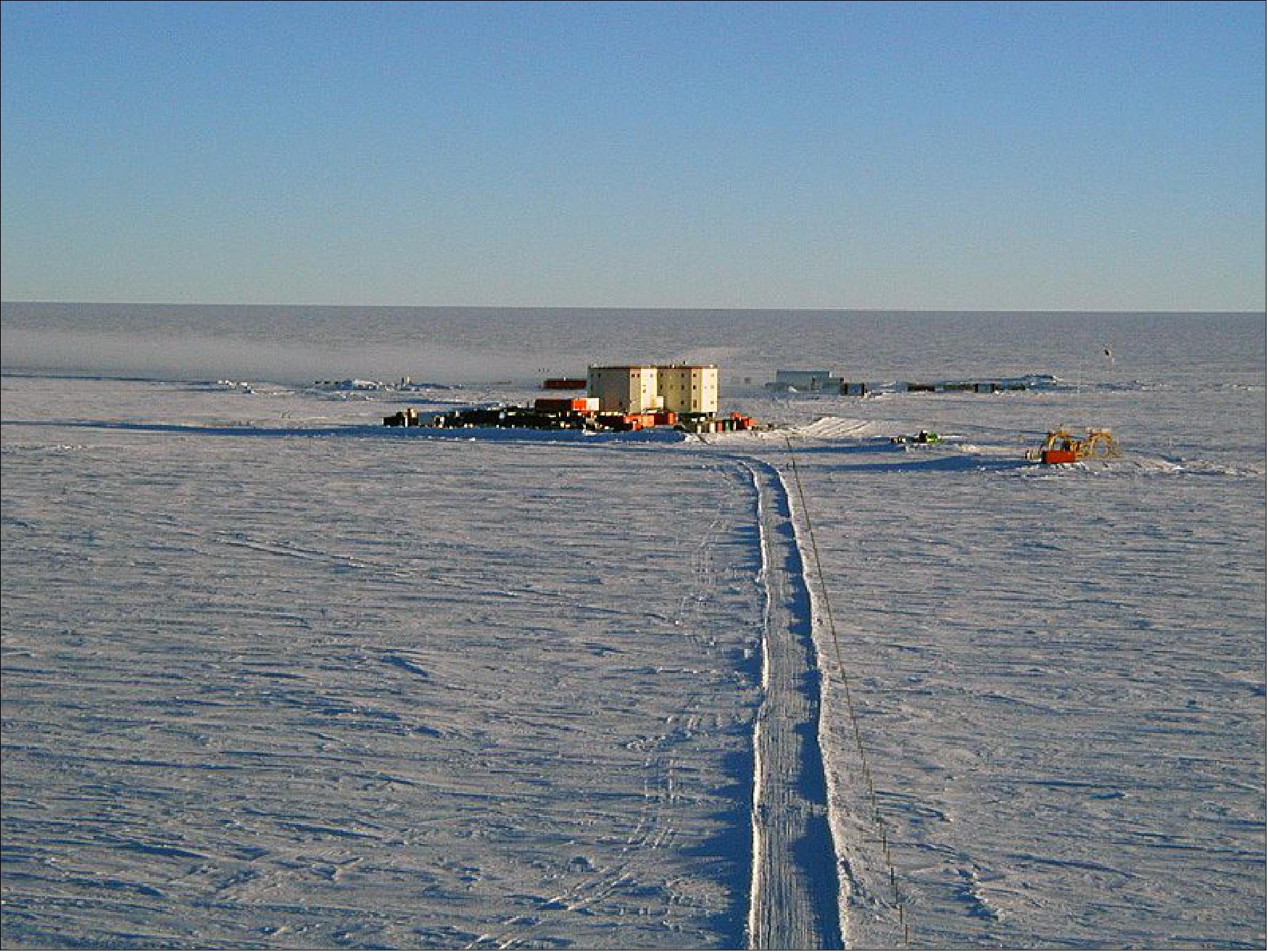
The new all-year facility, Concordia Station, became operational in 2005. The first winterover began with a staff of 13 (eleven French and 2 Italians) in February 2005.
Most of the cargo is moved to Dome C by traverse from DDU (Dumont d'Urville) Station, covering 1,200 km in 7 to 12 days depending on weather conditions. Station personnel and light cargo arrive by air, using Twin Otter aircraft from DDU or Mario Zucchelli Station at 1200 km.

Recent Events at Station Concordia
• May 12, 2022: The penultimate sunset at Concordia research station in Antarctica marks the beginning of a very exciting time for the 12-member crew: the coming of Antarctic night and the winter-over. 2)
- ESA sponsored medical doctor Hannes Hagson and his crew mates are finally embarking on their ‘real’ mission in Antarctica: living and work in isolation for six months in the name of spaceflight research.
- The Italian-French outpost Concordia is located 3233 m above sea level where temperatures can drop to –80°C in the complete frozen darkness outside. The sun disappears behind the horizon for four months. No supplies or people can be flown in during the winter months; and the high altitude causes the crew to experience chronic hypobaric hypoxia or lack of oxygen in the brain.
- These conditions are as close to living on another planet as humans can get on Earth.
- For this reason, Hannes is facilitating biomedical experiments on himself and his crewmates to understand how humans cope with living in extreme isolation. From sleep studies to gut health measurements to mindful practices, the crew are poked and prodded to help researchers understand and overcome the challenges extreme environments, like space, pose to present and future explorers.

• March 10, 2022: Twilight is a long affair at research station Concordia, situated just a few 1000 km from the South Pole. The Sun disappears completely behind the horizon for over four months in winter. Each day during the Antarctic autumn the sunset is earlier and earlier until it simply does not appear at all. 3)
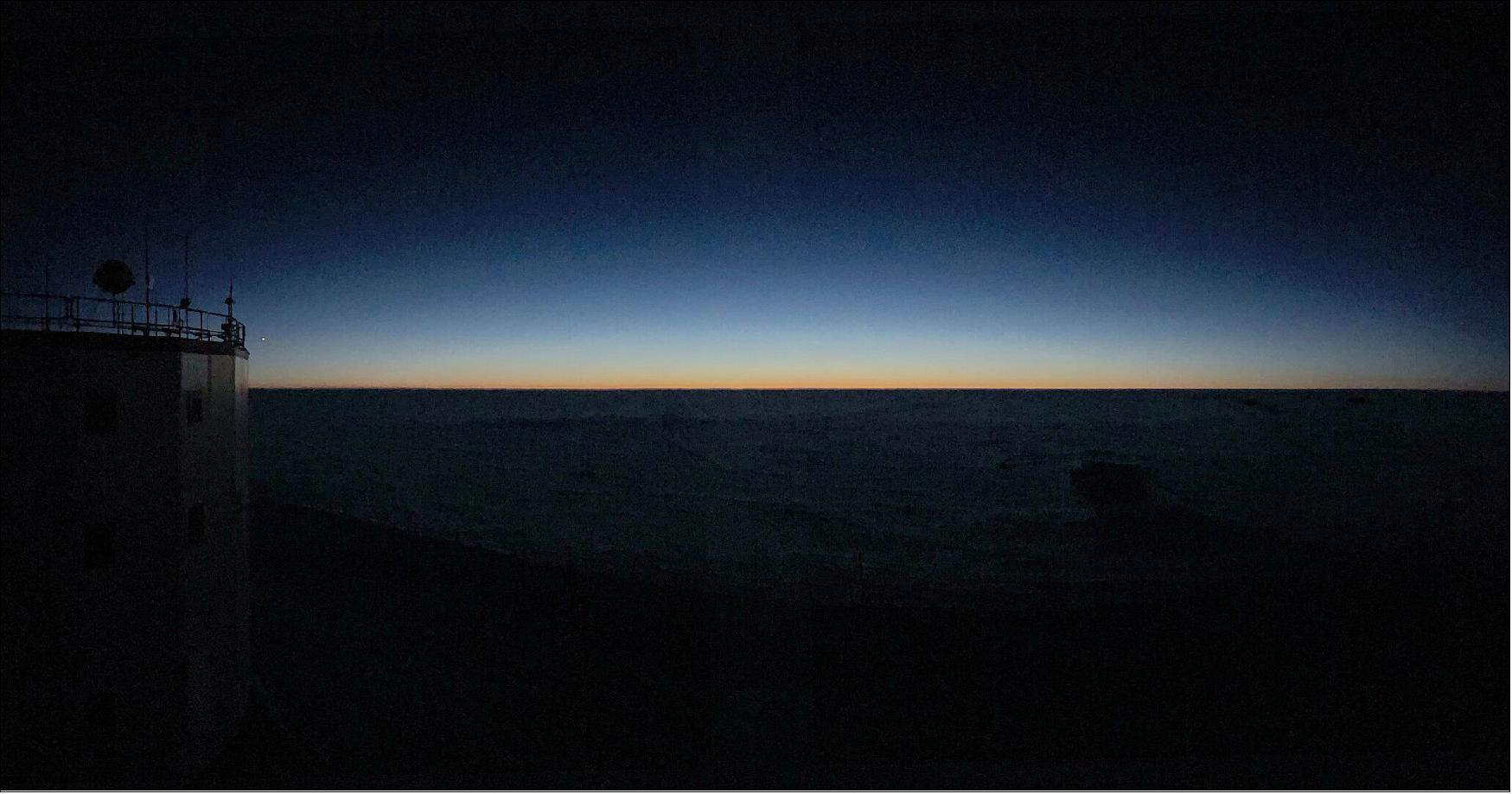
- The station consists of two towers, one for noisy machinery and work and the quieter living quarters. This year’s ESA-sponsored medical doctor Hannes Hagson took this picture, the view from the dining area, at 23:00 local time last Sunday; the quiet tower is visible on the left.
- Hannes is facilitating biomedical experiments on himself and his crewmates to understand how humans cope with living in extreme isolation. The Italian-French outpost Concordia is located 3233 m above sea level so the crew experience chronic hypobaric hypoxia or lack of oxygen in the brain.
- With irregular sunlight, no quick rescue, extreme low temperatures and little oxygen in the air this is as close as it gets to living on another planet, on Earth.
• August 20, 2021: After four months of darkness, it is finally time to rise and shine for the crew at Concordia Research Station in Antarctica. The most-welcome Sun finally made its appearance on 11 August and ESA-sponsored medical doctor Nick Smith was not about to miss it. 4)
- For nine months Nick and his fellow crew mates have been living and working in one of the most isolated, confined and extreme environments on Earth, with no way in or out of the Station during the winter-over period.
- Nick is overseeing experiments in human physiology and biology, atmospheric physics, meteorology, and astronomy, among other disciplines. Along with the rest of the crew, he is also maintaining the base – one of only three to run year-round in the Antarctic.
- Four months of complete darkness is quite the challenge, and one researchers are very interested in studying from a physiological and psychological point of view. From questionnaires to blood and stool samples, the crew are poked and prodded to understand how better to prepare humans for deep space travel.
- Social dynamics are also of interest to researchers during the period of darkness. Stress brought on by lack of sunlight, changing sleep patterns, fatigue and moodiness can affect the group. The crew are especially encouraged to take on group activities and get creative to combat the isolation of the winter. And not just with their own station crew.
- Bases across Antarctica take part in the annual Antarctic Film Festival. Crews from each base submit an entry for different categories, and the creativity and cooperation required to come up with an idea and script, film and edit the entry makes for friendly competition and camaraderie. Look out for 2021 entries here.
- Follow the adventures in science and socialisation at Concordia on the blog.

• July 13, 2021: A fortnight after the 21 June winter solstice in Antarctica, the crew at Concordia Research Station are slowly welcoming the return of sunlight. This photo was taken by ESA-sponsored medical doctor Nick Smith on 1 July at noon. 5)

- Confined in extreme conditions, the crew at Concordia – one of three Antarctic stations inhabited all year long – find solace in traditions. Midwinter often includes well wishes from other Antarctic and sub-Antarctic stations as well as communal projects. The crew this year brewed their own beer to mark the occasion.
- As well as offering around nine months of complete isolation, Concordia’s location at 3233 m altitude means the crew experience chronic hypobaric hypoxia – lack of oxygen in the brain. Temperatures can drop to –80°C in the winter, with a yearly average of –50°C. The temperature at the time of this image was –65°C, with wind chill at about –80°C.
- As a station set in Earth’s harshest space, Concordia is an ideal stand-in for studying the human psychological and physiological effects of extreme cold, isolation and darkness.
- Nick is working on seven experiments, looking in general at the effects of isolated, confinement and extreme environment, analogous to a lunar or martian station, on mindfulness, cognition, risk taking, decision making, immune systems, stress, eye health, sexual security, and social dynamics. He has collected many samples and questionnaires over the past nine months.
- The crew are headed for the home stretch of their Antarctic residency which will bring not only sunlight but also fresh crew. Researchers arriving for the summer campaign means a lot of preparatory work for the current crew.
- In the next few weeks, they will need to plough the skiway, remove snow around the station, deep clean, and in the case of Nick, prepare his samples for return to Europe.
• April 9, 2021: ESA-sponsored medical doctor Nick Smith snapped this photo of the storage containers at Concordia research station in Antarctica shortly before sunset, 8 April 2021.6)
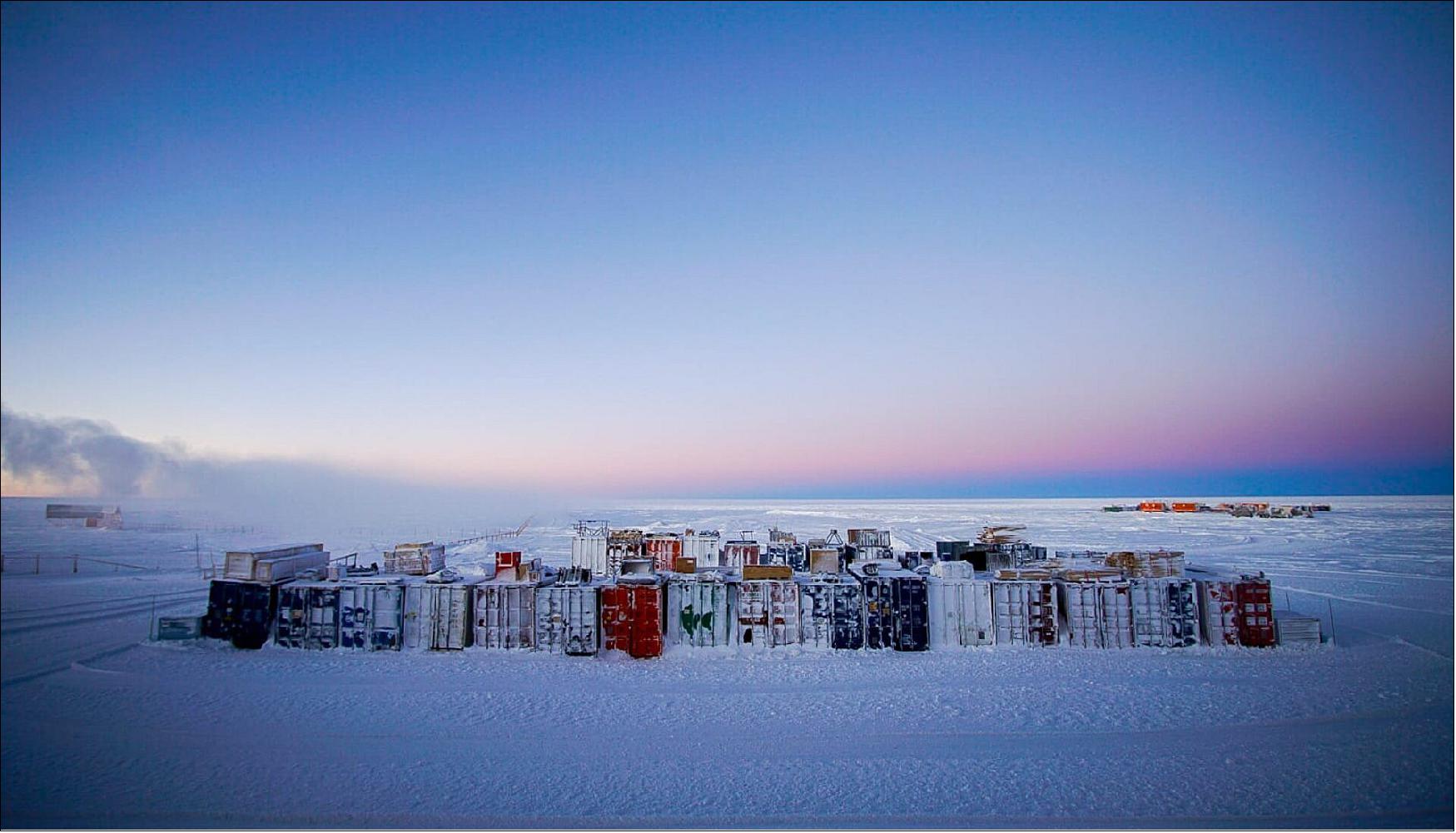
- Science for the benefit of space exploration does not only happen off planet. While some studies require the weightless isolation of the International Space Station, Antarctica also provides the right conditions for investigating the consequences of spaceflight, and it is a little easier to access than space.
- Part of the 17th crew to spend an entire year at one of the most remote bases in the world, Nick and 11 other crew members have taken up the adventurous challenge in the backdrop of a pandemic to continue important research that is furthering space exploration.
- Located at the mountain plateau called Dome C, Concordia is a collaboration between the French Polar Institute and the Italian Antarctic programme, and is one of only three bases that is inhabited all year long.
- As well as offering around nine months of complete isolation, Concordia’s location at 3233 m altitude means the crew experience chronic hypobaric hypoxia – lack of oxygen in the brain.
- During the Antarctic winter, the crew of up to 15 people also endure four months of complete darkness: the sun disappears from May and is not seen again until late August.
- Temperatures can drop to –80°C in the winter, with a yearly average of –50°C. The temperature at the time of this image was -65°C, with wind chill at about -80°C. To put this cold into perspective, it was so cold that the camera battery died within ten minutes.
- As a station set in Earth’s harshest space, Concordia is an ideal stand-in for studying the human psychological and physiological effects of extreme cold, isolation and darkness. For the rest of the year, Nick is poking and prodding the crew for samples to study changes in mood, immune systems, blood cells, and gut health.
• November 11, 2020: While the world continues to navigate the COVID-19 global pandemic, operations at Concordia research station in Antarctica have continued fairly uninterrupted. 7)
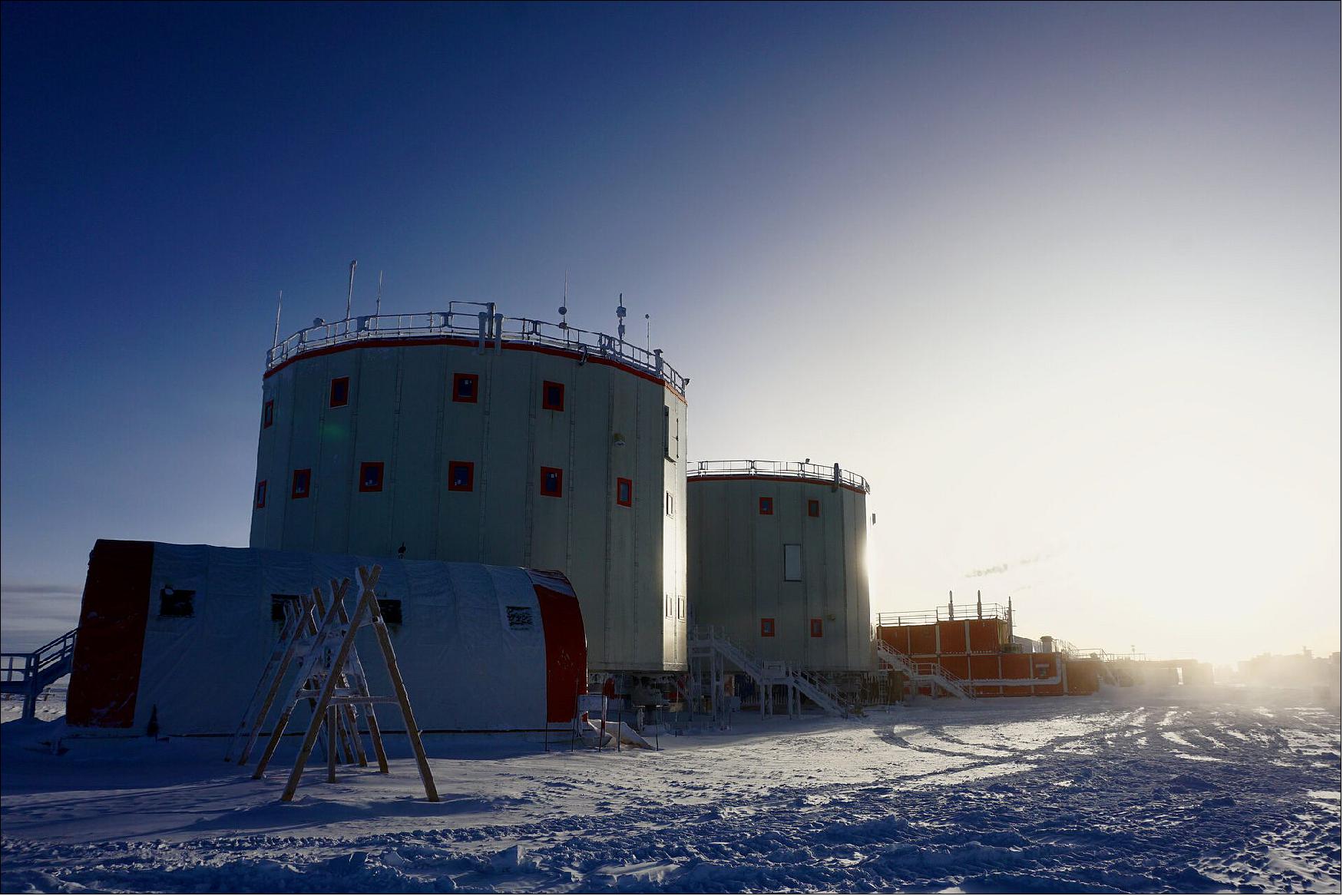
- Located at the mountain plateau called Dome C in Antarctica, Concordia is one of only three bases that is inhabited all year long. The current 12 inhabitants arrived in November 2019. They said goodbye to the summer crew and the last plane for nine months in February 2020, just weeks before the global pandemic was officially announced.
- While populations around the world isolated at home, life continued as normal at Concordia.
- “Who would have thought we didn’t have to come all the way here to study isolation,” says ESA sponsored medical doctor Stijn Thoolen.
- Throughout the year, Stijn has been busy collecting blood and stool samples and coordinating questionnaires and other activities for studies on altitude problems, immunity and hygiene, mindfulness and, in a first for the Concordia crew, sex.
- Between the extreme altitude – 3233 m above sea level means the crew experience chronic hypobaric hypoxia or lack of oxygen in the brain – and four months of total darkness during the winter, the base is fertile ground to research the effects of isolated, confined and extreme environments on the human body and mind.
- For this reason, each year ESA sponsors a medical doctor to oversee biomedical experiments at the base.
- Luckily, operations can continue for the 2020-21 season albeit at a reduced capacity. Incoming medical doctor Nicholas Smith and his crewmates have had a challenging time preparing for their year at the base but are due to arrive in the coming week, after a two-week quarantine in Tasmania, Australia.
- If you are a medical doctor and are interested in a winter over in Antarctica, applications are open for Concordia Research MD for the 2022 winter-over season. Deadline for applications is 22 January 2021. Please note that the COVID-19 pandemic and regulations might impact this schedule.
- A collaboration between the French Polar Institute (IPEV) and the Italian Antarctic program (PNRA), Concordia will soon also welcome a reduced number of scientists for the summer campaign. Researchers from a range of disciplines, including meteorology, glaciology and astronomy, spend weeks collecting samples and running tests at the bustling station. However, due to the pandemic the summer season will end a few weeks earlier than usual, by mid-January.
- Researchers can look out for a joint ESA/IPEV/PNRA Announcement of Opportunity for biomedical research at Concordia in January 2021. Interested science teams can propose biomedical experiments that, if selected, will be implemented via ESA at Concordia.
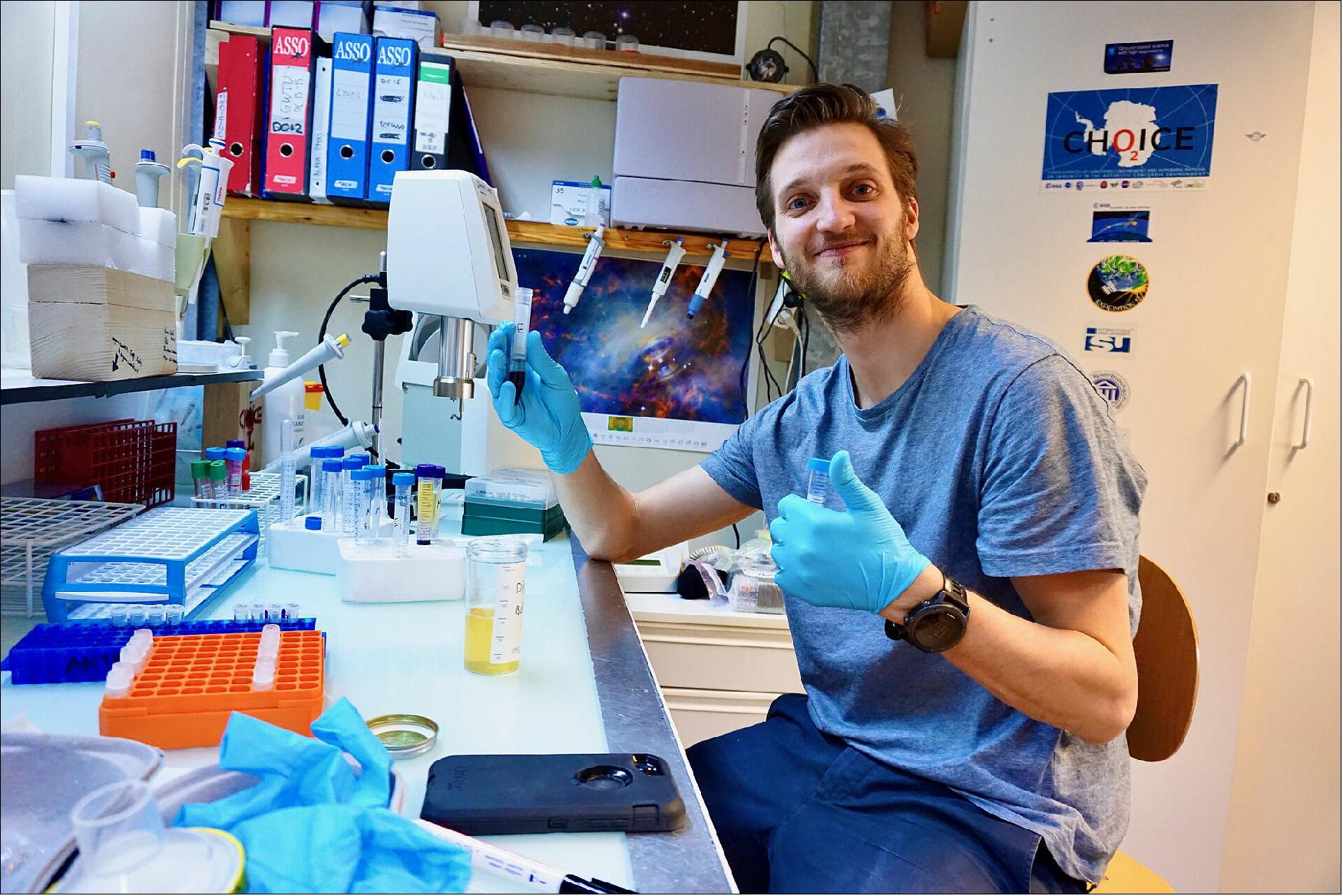
• September 25, 2020: This year marks two decades since the first ESA medical doctor set foot in Antarctica, running research at one of the most extreme places on Earth in preparation to explore far beyond it. 8)
- The crew of Italian-French research station, Concordia, in Antarctica, are subjected to almost nine months of complete isolation per year. The station’s location, at 3233 m altitude, means inhabitants also experience chronic hypobaric hypoxia – lack of oxygen to the brain – making it an ideal environment to better understand how humans adapt and survive in extreme conditions.
- During the Antarctic winter, the crew of up to 15 people also endure four months of complete darkness: the sun disappears from May and is not seen again until late August. Temperatures can drop to –80°C in the winter, with a yearly average of –50°C.
- After reviewing 20 years of space research on Earth, researchers have established sound knowledge on this topic. Some of the tips below will come as no surprise, but solidifying this research is what helps space agencies choose astronauts who will explore farther, and achieve their mission – whether that is on the Moon, Mars or elsewhere.
1) Exercise is important: One study divided the team into two groups. They asked one group to follow an exercise regime and the other to do little activity. The active group experienced a steady mood, while the “lazy” group showed more mood swings.
2) Practice to keep those skills fresh: Travelling in a spaceship to Mars takes nine months, will a martian astronaut be able to pilot their spacecraft to a safe landing without being able to practice for all that time? One crew in Concordia was trained to dock the Soyuz spacecraft to the International Space Station on actual training hardware. The crew was again divided into two. One group practised regularly and the others were only asked to dock in simulation at the end of their stay – no surprise, practice does help to ensure you keep your skills.
3) Blue light keeps you alert: Now a standard feature on modern computers and phones, you can set a ‘night light’ or red filter to dilute color of the screen to stop you from staying awake. But does it really work? Research in Concordia has shown that blue light during the four months of darkness does keep the crew awake and more alert. This can be a good thing if you need to do a critical task, but conversely it is better to filter it out if you want a good night’s rest.
4) Lack of oxygen is not good for sleep: Insomnia plagues Concordians, and research has shown that part of the problem is sleep apnea, whereby breaths are skipped and less oxygen is inhaled. Mission designers need to keep this in account for future spacecraft that would preferably be built with less atmospheric pressure, like a jumbo jet. The results from this study are also significant for people who suffer from sleep apnea at home.
5) Get regular sleep: Sleep is good, but regular sleep is even better. Concordians who forced themselves to go to bed at fixed times even during four months without sunlight by following researchers’ schedules performed better, and felt better, than team members who went to bed when they felt like it. It is not called the Circadian rhythm for nothing.
6) Believe in yourself: People who feel they have the resources to cope with the extreme environment in Antarctica before they leave, show a quicker recovery to the thin air and humidity on site. Research showed that more positive people, before even setting foot in Antarctica, adapted better physically to the extreme environment.
7) Sunlight is best: Over time your eyes become more sensitive without sunlight and sleep is affected. These results suggest that during long-term daylight deprivation, retinal sensitivity to blue light increases, whereas circadian rhythm stability decreases and sleep–wake timing is delayed.
- “Most of these tips should not come as a surprise, but this recap of 20 years of research and the research behind the tips above were ground-breaking at the time, they have now become common knowledge,” says Jennifer Ngo-Anh, research coordinator for ESA’s human and robotic exploration.
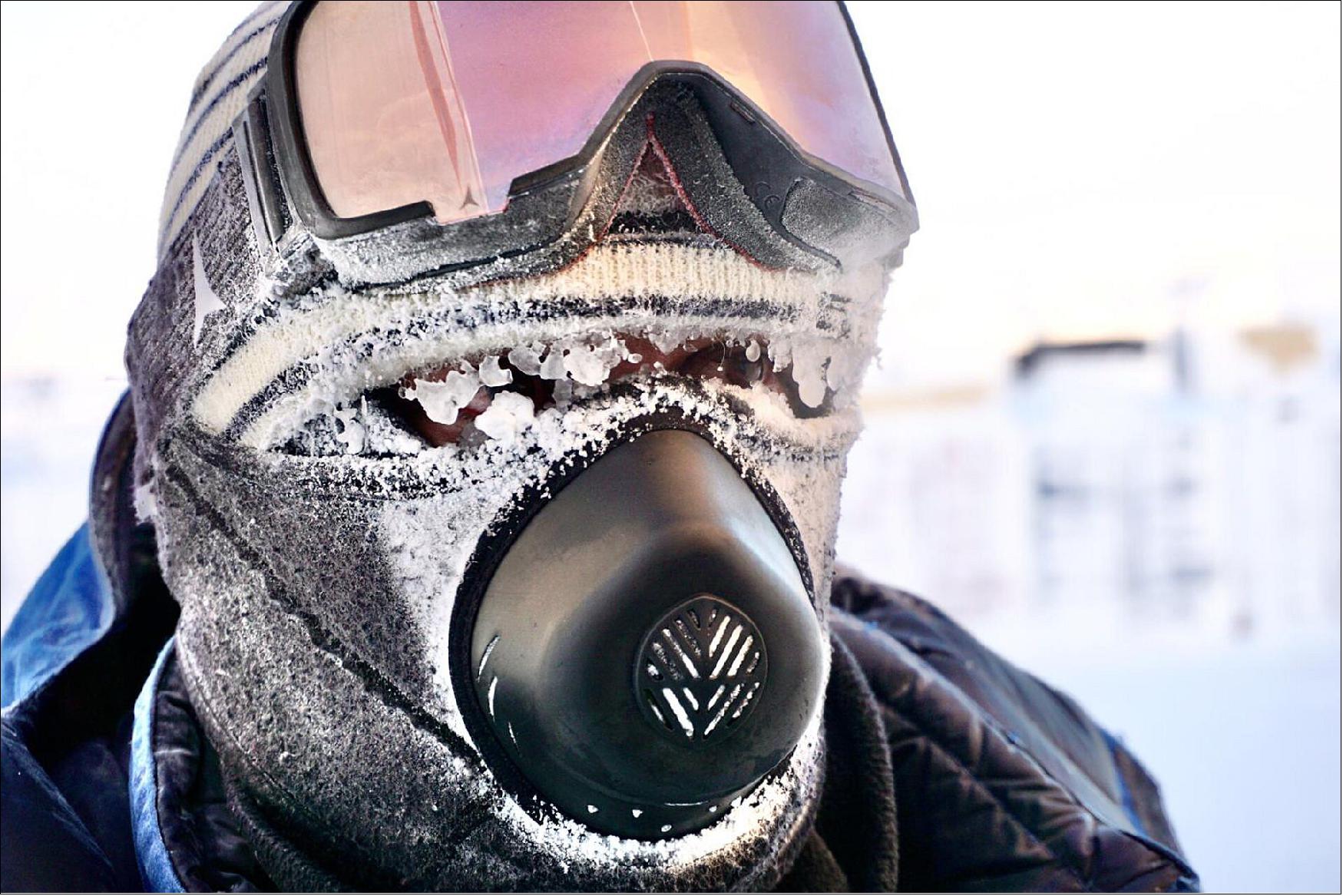
- “It is important to have scientific justification behind our strategy for selecting and training astronauts as we design and prepare for missions farther into our Solar System,” continues Jennifer, “also there are always surprises whereby diligent research has shown the opposite of what was expected.”
- Travelling on long-haul flights has long been associated with deep vein thrombosis, or blood clots in the legs. The lower air pressure coupled with little movement sitting in aircraft seats were logical factors to blame, but research on the crew at Concordia showed, surprisingly, that the lower air pressure did not seem to have an effect.
- “Science is about showing new, unexpected correlations, but also proving what is generally well accepted. Here’s to 20 years of science in Antarctica and many more to come,” concludes Jennifer.
• August 13, 2020: After four months of darkness, the Sun finally rises on 11 August at Concordia research station in Antarctica. The crew are understandably reverent. 9)
- They run experiments in human physiology and biology, atmospheric physics, meteorology and astronomy, among other disciplines, as well as maintain the base – one of only three to run year-round on the Antarctic Peninsula.
- Four months of complete darkness is quite the challenge, one researchers are very interested in studying from a physiological and psychological point of view. From questionnaires to blood and stool samples, the crew are poked and prodded to understand how better to prepare humans for deep space travel.
- Social dynamics are also of interest to researchers during the period of darkness. Stress brought on by lack of sunlight, changing sleep patterns, fatigue and moodiness can affect the group. The crew are especially encouraged to take on group activities and get creative to combat the isolation of the winter.
- The first sunrise is always a remarkable moment, signalling the home stretch of their Antarctic residency. From now on the winter crew will start preparing for summer and the return of scientists that arrive for the warmer months starting in November. The base is cleaned thoroughly, machinery is serviced, tents are erected and heated, and the runway is cleared of snow. Extensive work is required to welcome the new arrivals back to the base at the end of the world.
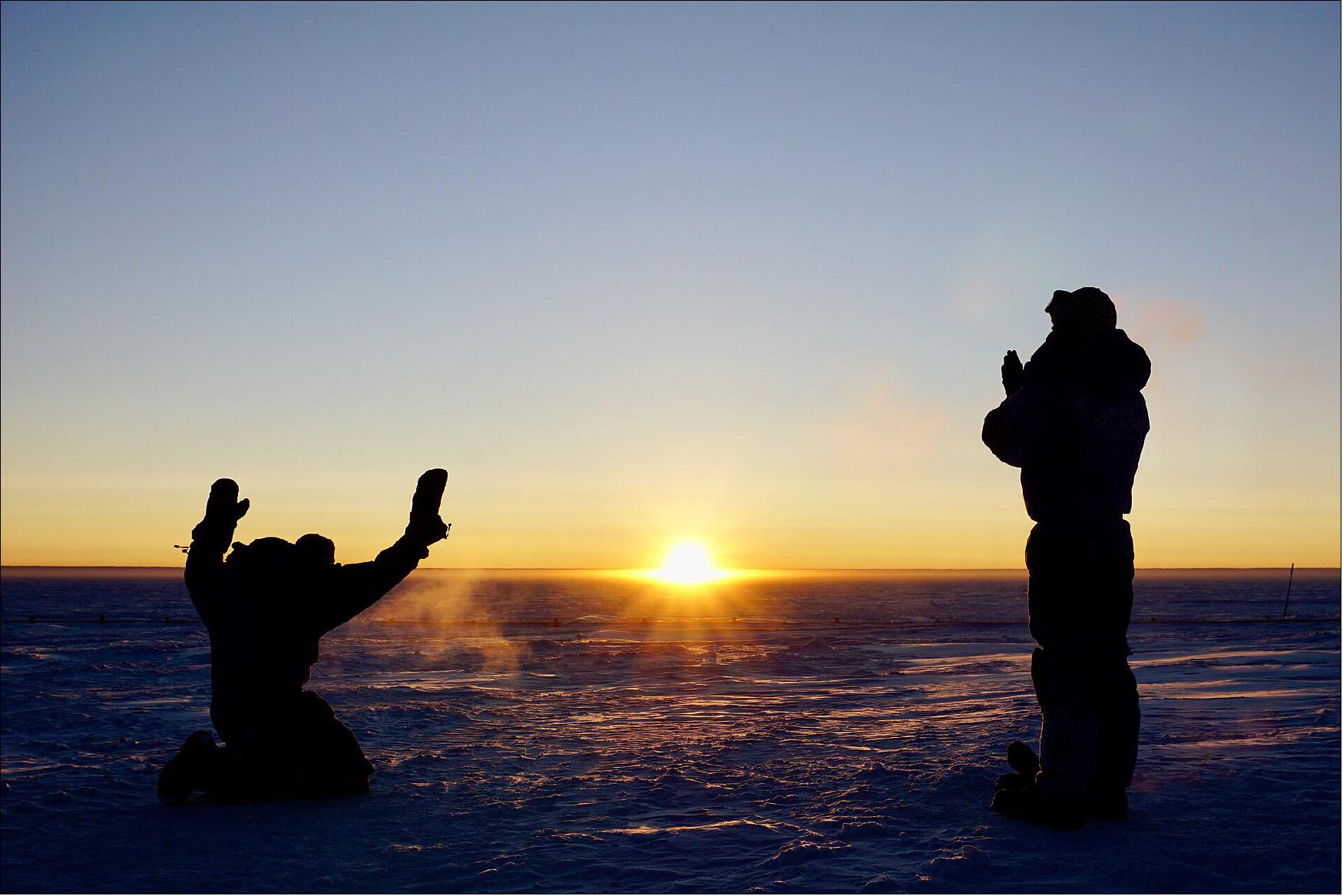
• August 04, 2020: In a peninsula far, far away, a laser shoots into the sky to study the Antarctic atmosphere at Concordia research station. 10)
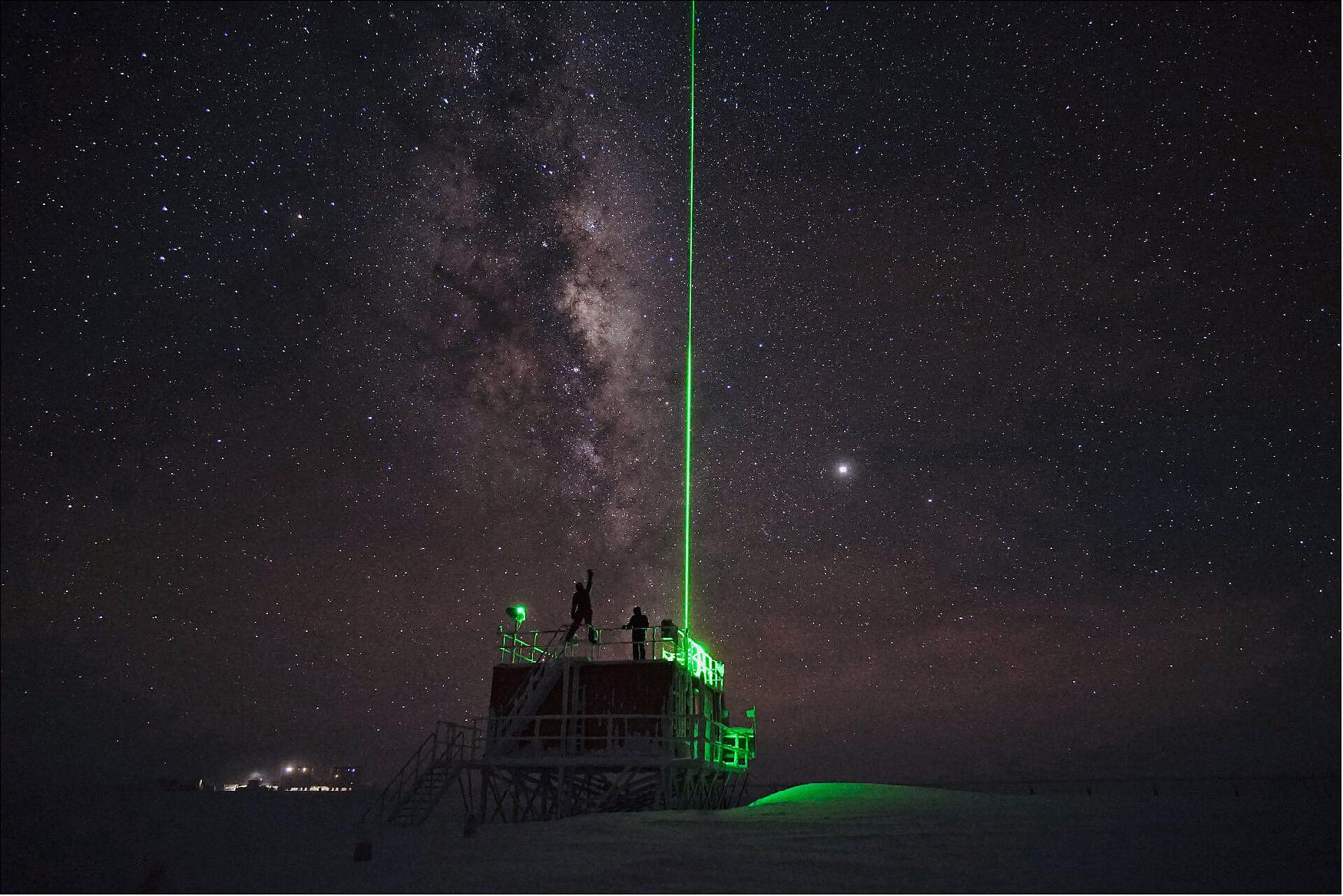
- The LIDAR (Light Detection and Ranging) instrument is a remote sensing technique that uses light to study an object.
- A pulsed laser beam is aimed at the target and properties of the resulting scattered light are recorded by sensors. Using these measurements, researchers collect information about the atmosphere, including density, temperature, wind speed, cloud formation and aerosol particles.
- LIDAR and SONAR (Sonic detection and ranging) instruments help monitor the Atmospheric Boundary Layer, the 1 km thick bottom layer of the troposphere where changes on Earth’s surface strongly influence temperature, moisture and wind.
- These changes to Earth’s surface are largely caused by human activity. Increased greenhouse gas emissions are raising temperatures and the release of chlorofluorocarbons is thinning the ozone layer, particularly in the Polar Regions.
- Atmospheric physics and chemistry is one field of research undertaken at Concordia to assess the Antarctic climate and overall climate change.
- Concordia also runs biomedical studies as an analogue for space exploration. Each year ESA sponsors a research doctor to continue studies on the psychological, physiological and social effects of living in an isolated, confined and extreme environment.
• May 22, 2020: Meet the Experts: Isolation in Antarctica. 11)
• May 18, 2020: The 16th crew at Concordia research Station in Antarctica to spend a full winter at the facility, wave goodbye to the Sun as it descends below the horizon, not to return for four months. 12)
- Concordia research station is one of three stations operating year round for science in the middle of the Antarctic ice sheet. Located at Dome C on the Antarctic peninsula, the station sits 3200 m above sea level.
- If the altitude does not steal your breath, the cold certainly will: temperatures can drop to –80°C in the winter, with a yearly average temperature of –50°C.
- Isolation in a cold, dark environment on Earth makes an ideal stand-in for space to better prepare us for exploration of our Solar System. Researchers come to Concordia to study not only astronomy, meteorology and glaciology but also human physiology and psychology.
- Researchers are interested in how this extreme environment can be a risk to the human body and mind. Data from these studies is preparing humans for life in outer space beyond low Earth orbit.
- ESA-sponsored medical doctor Stijn Thoolen coordinates this year’s biomedical research experiments at Concordia to assess the prolonged effects of isolation on the human body and mind.
- He collects blood, stool and urine samples to track changes in blood volume, immune system and gut bacteria and how they impact our health. Stijn also facilitates stress and coordination tests and follows social dynamics to understand the roles stress plays in making or breaking a group in isolation.
- The coming months will prove the most challenging for the group but potentially also the most rewarding.
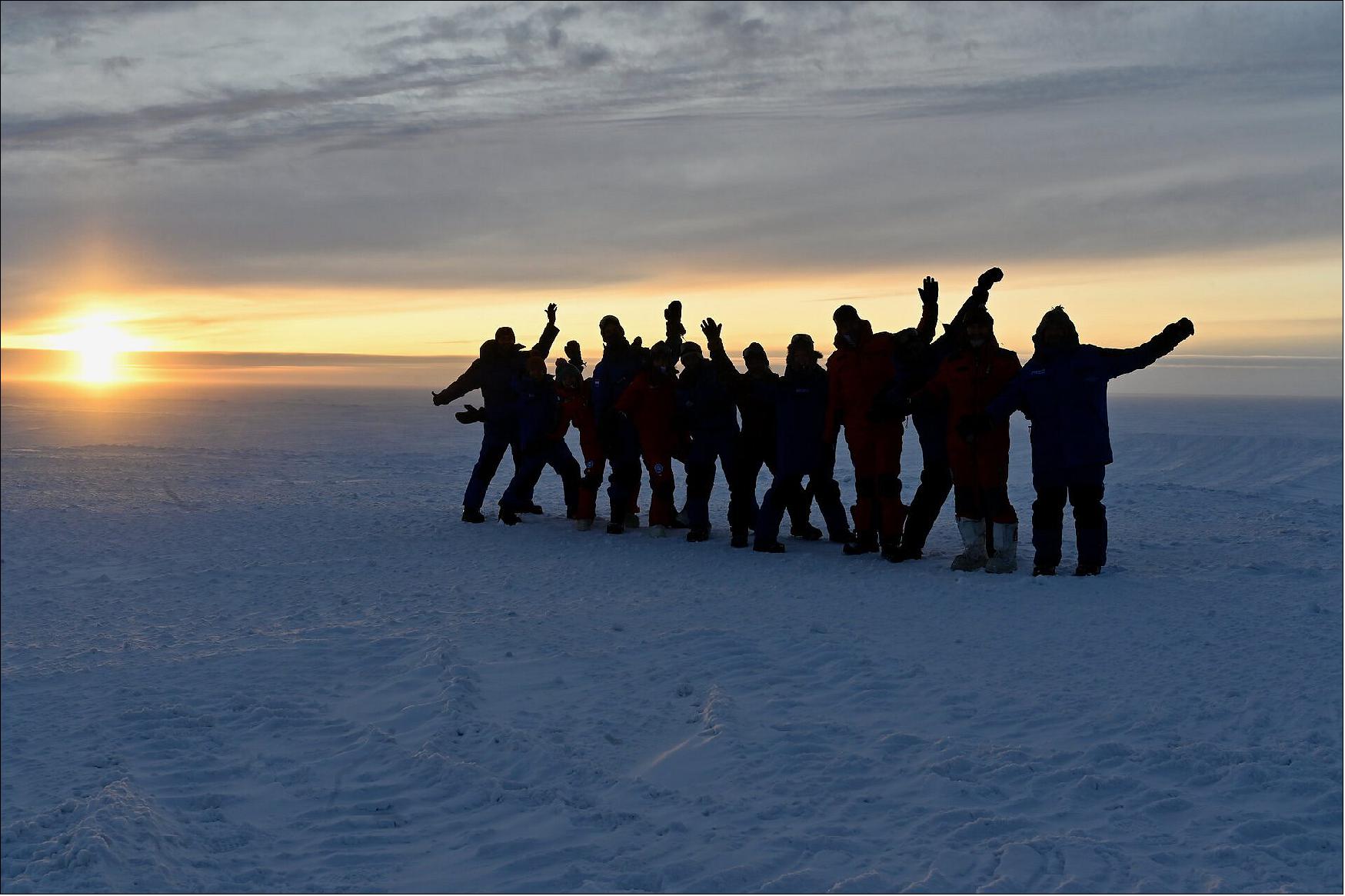
• March 22, 2013: Concordia research station in Antarctica is located on a plateau 3200 m above sea level. A place of extremes, temperatures can drop to –80°C in the winter, with a yearly average temperature of –50°C. 13)
- As Concordia lies at the very southern tip of Earth, the Sun does not rise above the horizon in the winter and does not set in the summer. The crew must live without sunlight for four months of the year.
- The altitude and location mean that the air in Concordia is very thin and holds less oxygen. Venturing outside the base requires wearing layers of clothes and limits the time spent outdoors.
- During the harsh winter no outside help can be flown in or reach the base over land – the crew have to solve any problems on their own.
- In addition, Concordia sits in the largest desert in the world. The air is extremely dry, so the crew suffer from continuously chapped lips and irritated eyes.
- No animals can survive in this region – even bacteria find it hard coping with the extreme temperatures. The nearest human beings are stationed some 600 km away at the Russian Vostok base, making Concordia more remote than the International Space Station.
- In the great open landscape covered in darkness, colors, smells and sounds are almost non-existent, adding to the sense of loneliness.
- The isolation and sensory deprivation can wreak havoc on crewmembers’ biological clock, making it hard to get a good night’s sleep.
- Despite all these hardships, up to 16 people spend around a year at a time living in Concordia in the name of science. Far removed from civilization, the white world of Antarctica offers researchers the opportunity to collect data and experiment like no other place on Earth.
- The base is so unlike anything found elsewhere in the world that ESA participates in the Italian-French base to research future missions to other planets, using the base as a model for extraterrestrial planets.

The French–Italian Concordia station’s program of research includes glaciology, human biology and the atmosphere. ESA uses the base to prepare for future long-duration missions beyond Earth. During the winter, Concordia is under almost total darkness, with an average temperature of –51ºC and a record low of –85ºC. It is an ideal place to study the effects on small, multicultural teams isolated for long periods in an extreme, hostile environment.
Auroras occur frequently over both the North and South polar regions, but are often difficult to see from populated areas. During periods of increased solar activity, the lights sometimes extend to populated latitudes.
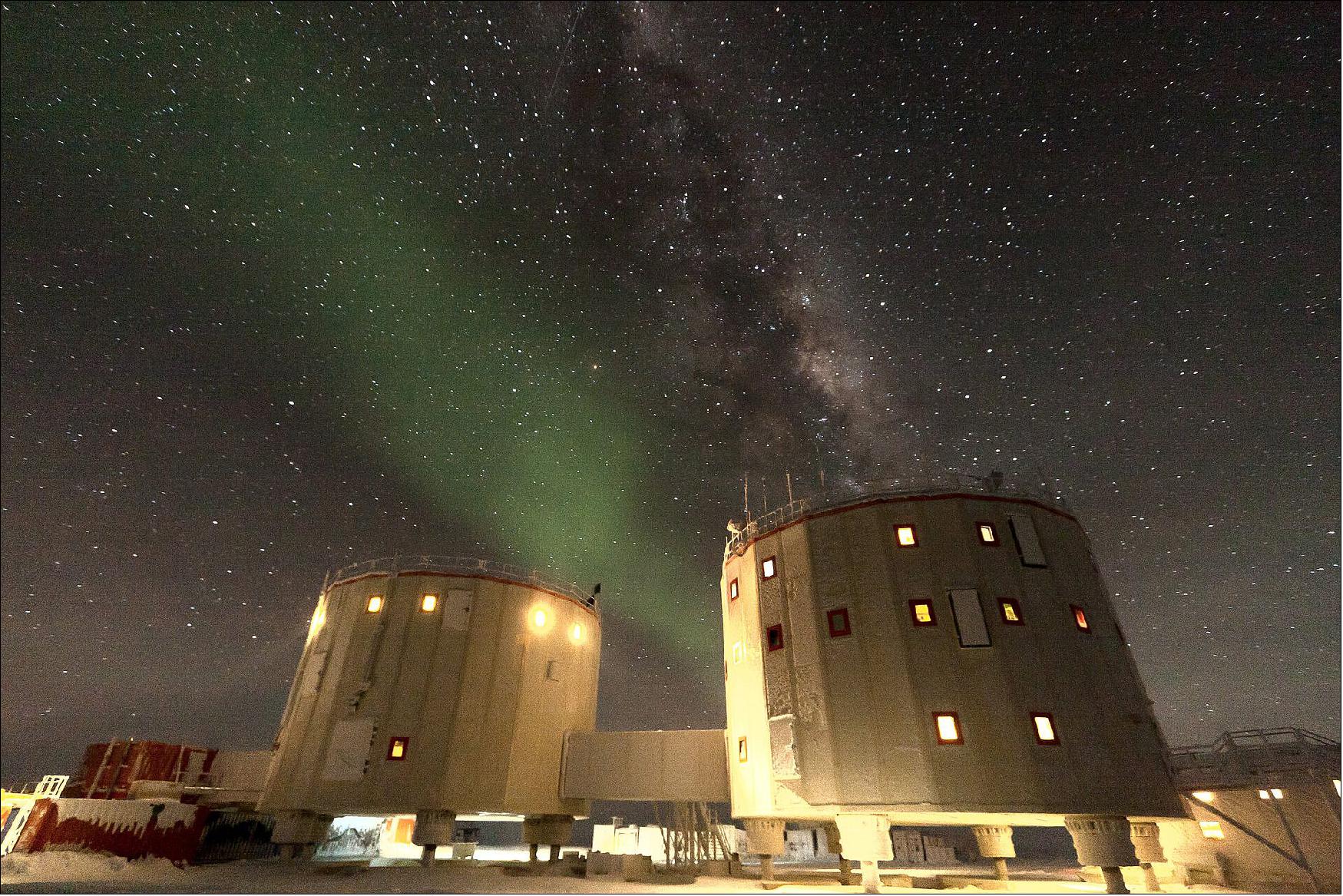
References
1) ”Concordia Station,” Wikipedia, URL: https://en.wikipedia.org/wiki/Concordia_Station
2) ”Telling sunset,” ESA Science & Exploration, 12 May 2022, URL: https://www.esa.int/ESA_Multimedia/Images/2022/05/Telling_sunset
3) ”The long goodbye,” ESA Science & Exploration, 10 March 2022, URL: https://www.esa.int/ESA_Multimedia/Images/2022/03/The_long_goodbye
4) ”Rise and shine,” ESA Science & Exploration, 20 August 2021, URL: https://www.esa.int/ESA_Multimedia/Images/2021/08/Rise_and_shine
5) ”Antarctic noon,” ESA Science & Exploration, 13 July 2021, URL: https://www.esa.int/ESA_Multimedia/Images/2021/07/Antarctic_noon
6) ”Contained confinement,” ESA Science & Exploration, 9 April 2021, URL: https://www.esa.int/ESA_Multimedia/Images/2021/04/Contained_confinement
7) ”Concordia in 2020,” ESA Science & Exploration, 11 November 2020, URL: https://www.esa.int/Science_Exploration/Human_and_Robotic_Exploration/Concordia_in_2020
8) ”20 years of ice-cold research: extremophile tips for healthy living,” ESA Science & Exploration, 25 September 2020, URL: https://www.esa.int/Science_Exploration/Human_and_Robotic_Exploration/Concordia/20_years_of_ice-cold_research_extremophile_tips_for_healthy_living
9) ”Salute to the Sun,” ESA Science & Exploration, 13 August 2020, URL: https://www.esa.int/ESA_Multimedia/Images/2020/08/Salute_to_the_Sun
10) ”Return of the LIDAR,” ESA Science & Exploration, 04 August 2020, URL: https://www.esa.int/ESA_Multimedia/Images/2020/08/Return_of_the_LIDAR
11) Meet the Experts: Isolation in Antarctica,” ESA Science & Exploration, 22 May 2020, URL: http://www.esa.int/ESA_Multimedia/Videos/2020/05/Meet_the_Experts_Isolation_in_Antarctica
12) ”Last Antarctic sunset,” ESA Science & Exploration, 18 May 2020, URL: http://www.esa.int/ESA_Multimedia/Images/2020/05/Last_Antarctic_sunset
13) ”The remotest base on Earth,” ESA / Science & Exploration / Human and Robotic Exploration / Concordia, 22 March 2013, URL: https://www.esa.int/Science_Exploration/Human_and_Robotic_Exploration/Concordia/The_remotest_base_on_Earth
The information compiled and edited in this article was provided by Herbert J. Kramer from his documentation of: ”Observation of the Earth and Its Environment: Survey of Missions and Sensors” (Springer Verlag) as well as many other sources after the publication of the 4th edition in 2002. - Comments and corrections to this article are always welcome for further updates (eoportal@symbios.space).